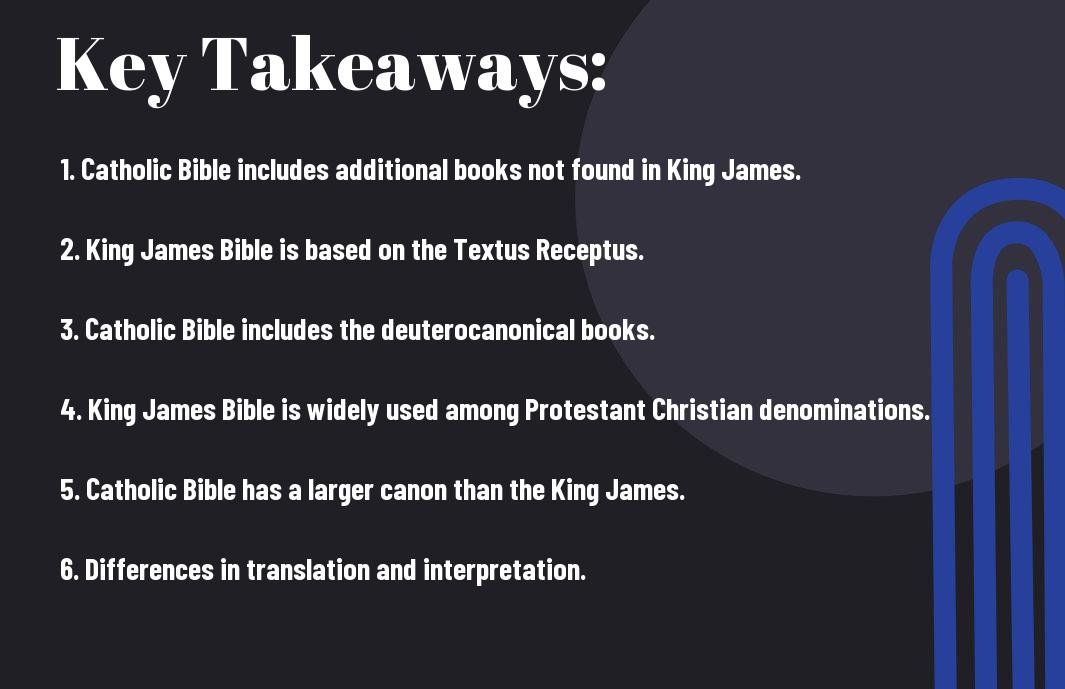In my years of studying theology and religious texts, I have come to appreciate the subtle yet significant variations between the Catholic Bible and the King James Bible. Many people are unaware of the differences in content, interpretation, and history of these two versions of the Bible, and it is crucial to understand the implications of using one over the other. In this blog post, I will delve into the important details and distinctions between the Catholic Bible and the King James Bible, shedding light on the implications these differences have for individuals and faith communities. Whether you are a devout Christian or simply interested in religious texts, the comparison of these two versions of the Bible is essential for a comprehensive understanding of the Christian faith.
Key Takeaways:
- Catholic Bible and King James are two distinct versions of the Bible with differences in content and historical background.
- The Catholic Bible contains additional books known as the Apocrypha, whereas the King James Bible does not include these books.
- The differences in translation and interpretation of certain passages can lead to variations in understanding and emphasis on specific theological concepts.
- The Catholic Bible is recognized by the Catholic Church, while the King James Bible is predominantly used by Protestant denominations.
- Both versions carry significant cultural and religious significance and have shaped the beliefs and practices of their respective religious communities.
History of the Catholic Bible and the King James Bible
To truly understand the differences between the Catholic Bible and the King James Bible, it’s important to dive into the history of how these two versions came to be. Both have unique origins and developments that have shaped their content and structure over the centuries.
Origins and development of the Catholic Bible
The Catholic Bible, also known as the Christian Bible, has a rich and complex history that dates back to the early years of Christianity. It includes a collection of books that are considered sacred and authoritative by the Catholic Church. The development of the Catholic Bible involved a series of discussions, councils, and debates within the early Christian community. The canonization process, which determined which books were included in the Bible, was a lengthy and sometimes contentious process, with different regions and traditions advocating for different texts. Ultimately, the Catholic Church established the official canon of the Bible at the Council of Trent in the 16th century. This process solidified the content of the Catholic Bible, including books that are not found in Protestant Bibles, such as Tobit, Judith, and the Wisdom of Solomon.
Origins and development of the King James Bible
The King James Bible, also known as the Authorized Version, has a more recent origin compared to the Catholic Bible. It was commissioned by King James I of England in the early 17th century and was intended to be a new English translation of the Bible that would be widely accepted and used by the Church of England. The King James Bible was produced by a committee of scholars and translators who worked diligently to create a version that reflected the theological and linguistic nuances of the original Hebrew and Greek texts. This translation process resulted in a version that has had a significant impact on English literature and religious worship. Its elegant and poetic language has made it a beloved and enduring translation in the English-speaking world.
Comparison of the Two Bibles
Obviously, the Catholic Bible and the King James Version (KJV) are two of the most popular and widely used versions of the Bible. While both versions contain the same 66 books of the Old and New Testaments, there are significant differences in terms of content, structure, language, and style. Here, I will compare the two Bibles to help you better understand the distinctions between them.
Differences in content and structure
When it comes to the content and structure of the two Bibles, the most significant difference lies in the inclusion of additional books in the Catholic Bible. These books, known as the deuterocanonical books, are not found in the KJV and are considered part of the Old Testament by Catholics. The KJV, on the other hand, follows the Protestant canon and does not include these additional books. Additionally, the arrangement and order of the books in the Old Testament also differ between the two versions, with the Catholic Bible following a different sequence compared to the KJV.
Differences in language and style
Another notable difference between the Catholic Bible and the KJV is the language and style in which the texts are presented. The KJV is known for its use of archaic language and majestic style, often employing poetic and rhythmic prose. On the other hand, the Catholic Bible tends to use more modern language, making it more accessible to contemporary readers. This variance in language and style can significantly impact the reading experience and interpretation of the sacred texts.
Impact and Influence of the Two Bibles
After understanding the version and differences of the Catholic Bible and the King James Bible, it’s crucial to recognize the influence and impact that these two versions of the Bible have had on religious practices, traditions, literature, and culture.
Influence on religious practices and traditions
The Catholic Bible and the King James Bible have both played integral roles in shaping religious practices and traditions. The influence of these two versions of the Bible is evident in the beliefs, rituals, and customs of their respective religious communities. The Catholic Bible has had a profound impact on the development of sacraments, prayers, and religious services in the Catholic Church. On the other hand, the King James Bible has greatly influenced Protestant denominations and their worship practices, including hymnody, preaching, and the observance of religious holidays. Both versions have contributed to the rich tapestry of religious diversity and traditions that exist within Christianity, shaping the way individuals and communities express their faith.
Influence on literature and culture
The influence of the Catholic Bible and the King James Bible extends beyond religious practices and traditions and into the realms of literature and culture. These two versions of the Bible have served as the inspiration for countless works of art, music, and literature. They have also contributed to the development of language, shaping the way people speak and write. The King James Bible, in particular, has had a significant impact on the English language, with many of its phrases and expressions becoming ingrained in the lexicon. The influence of these two versions of the Bible on literature and culture is a testament to the enduring relevance and power of the scriptures, transcending religious boundaries and permeating every aspect of human civilization.

Conclusion
From above, it is evident that the Catholic Bible and the King James Version are two distinct translations of the Bible, each with its own unique differences and similarities. While the Catholic Bible contains additional books and passages that are not found in the King James Version, the latter is known for its poetic language and historical significance. Ultimately, the choice between the two versions depends on your personal beliefs, preferences, and the purpose for which you intend to use the Bible. It is important to carefully consider these factors before making a decision and to seek guidance from knowledgeable sources to gain a deeper understanding of the differences between these two influential texts.
FAQ
Q: What is the Catholic Bible and the King James Bible?
A: The Catholic Bible and the King James Bible are two different versions of the Christian Bible. The Catholic Bible contains additional books not found in the King James Bible, known as the Apocrypha or deuterocanonical books. The King James Bible, also known as the Authorized Version, is a Protestant translation of the Bible.
Q: What are the differences between the two Bibles?
A: The main difference between the two Bibles is the inclusion of the Apocrypha in the Catholic Bible. Additionally, the Catholic Bible and the King James Bible differ in the organization of the books and slightly in the wording of certain verses.
Q: Which version is considered authoritative by Catholics and Protestants?
A: The Catholic Church considers the Catholic Bible to be authoritative, while many Protestant denominations consider the King James Bible as their authoritative version. However, there are many different translations and versions of the Bible used by different Christian denominations.
Q: How do the two Bibles impact the faith and practices of their respective followers?
A: The differences in the two Bibles can impact the faith and practices of their respective followers in terms of doctrine, theology, and religious practices. For example, the inclusion of certain books in the Catholic Bible may lead to differences in beliefs and practices compared to those of Protestant denominations who do not recognize these books as canonical.
Q: Are there any similarities between the Catholic Bible and the King James Bible?
A: Despite their differences, both the Catholic Bible and the King James Bible share the same core content of the Old and New Testaments. Both versions contain the teachings and narratives of Jesus Christ and the early Christian church, serving as the foundation of the Christian faith.

